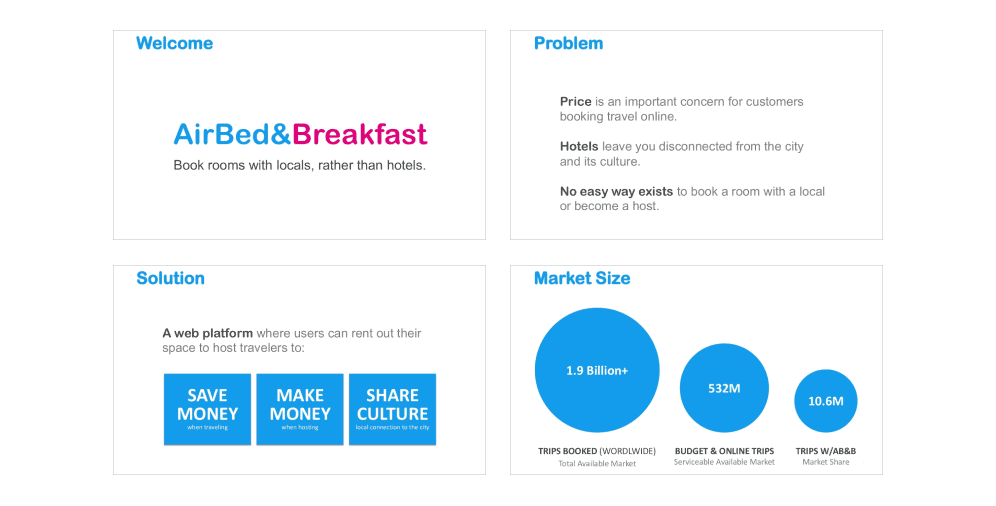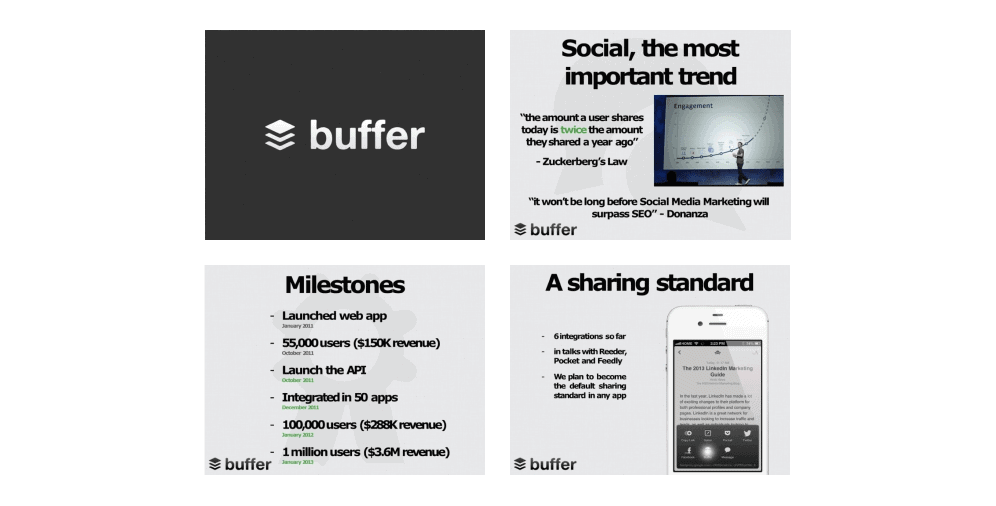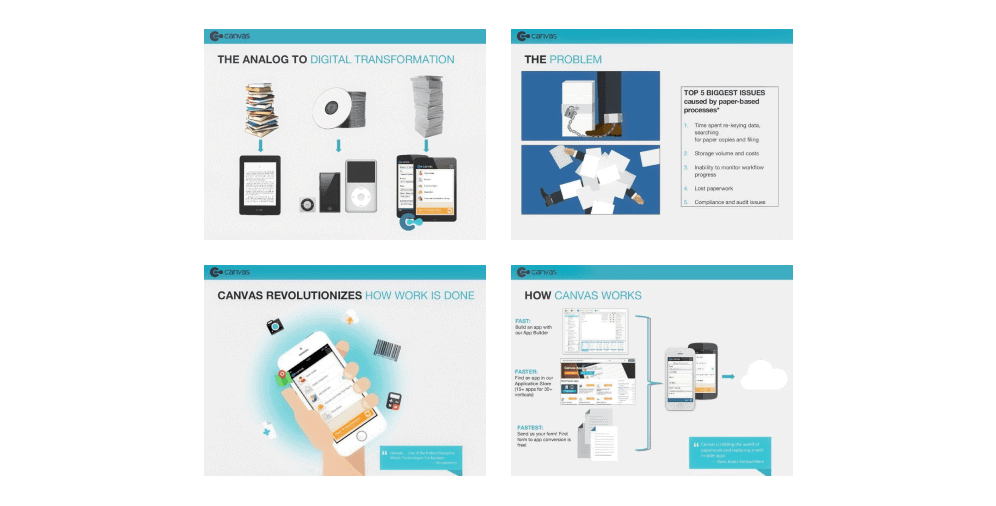Outline:
When considering today’s business giants such as Airbnb or Uber, it can be difficult to imagine that they once started as small enterprises. However, each of these successful companies began with an idea and an extraordinary amount of enthusiasm. Despite this, they were unable to realize their full potential without sufficient financing.
By securing substantial financial backing, entrepreneurs can successfully launch their businesses and bring them to market. The viability of their projects is dependent on how effectively the founders can demonstrate their concept’s validity. At this critical stage, it is essential to prepare a compelling pitch deck that demonstrates the project’s value and provides an incentive for potential investors to become involved.
In other words, a pitch deck is necessary to prove the concept’s worth and attract support. In this article, we will explore how to impress investors with a great pitch deck.
Understanding the Importance of a Pitch Deck in Startup Business
In the realm of startup company website design, many brands opt to prioritize their online presence to gain traction. However, this does not mean that startup pitch decks are becoming obsolete; in fact, their popularity continues to rise.
A pitch deck is a concise overview of a draft business plan that typically consists of 10 or more slides. It is not just a mere PowerPoint presentation, but rather a collection of business-related data that serves the purpose of acquiring financing. Investors need to comprehend your purpose and objectives, and a pitch deck is a structured and comprehensive way of presenting yourself as a business.
Moreover, a pitch deck serves as both a marketing and performance tool. It is the business mouthpiece that explains the validity of the project you want to establish. While money is certainly important, investors are human beings, and if you fail to evoke emotion, your chances of success will decrease.
Lastly, it is an effective visualization tool that creates a positive first impression on potential shareholders. It is a critical part of the communication process between founders and investors, and to execute it seamlessly, you need to exude your personal charm and passion to get them excited about your ideas.
Without a pitch deck, it is challenging to capture investors’ attention and build relationships. A great pitch deck is a vital aspect of any startup, and it is crucial to invest time and effort to ensure its success.
10 Key Components of an Effective Pitch Deck
When seeking investors for your startup, it’s essential to have a clear and concise pitch deck that presents your business idea professionally and persuasively. While investors are not inclined to invest based on sympathy, a well-structured pitch deck can provide them with the necessary facts and proofs to make an informed decision. Here is a comprehensive guide on how to make a great pitch deck that can create killer projects.
- Introduction: The introduction slide is the starting point of the communication process. It is crucial to include the company’s name, the business’s features, and the mission statement. A fully transparent and professional introduction can connect with investors from the beginning and set the stage for the rest of the pitch.
- Problem: Identify the problems your business intends to solve. Focus on two or more critical issues related to your business niche and potential customers. Avoid general statements and be specific to avoid ambiguity and uncertainty.
- Solution: Explain how your business will solve the problems you have identified. Avoid making assumptions and provide factual information on your product’s core functions and capabilities.
- Product: Introduce your product and outline its key features. Clearly identify how it differs from competitors in the market. Be precise and straightforward to persuade investors to take interest in your project.
- Market: Name the market your business operates in, its size, and your position within it. Determine your target audience and segments to show that your business operates in a real environment and not an imaginary setting.
- Traction: Present evidence that your business is developing and worth investing in. Use numbers and statistics to demonstrate your business’s scope and scale, illustrating your overall proficiency, progress, and other achievements.
- Business Model: Explain how your business operates and how it will generate revenue. Define your business structure and illustrate its mechanisms to provide investors with a clear understanding of your project’s functioning.
- Competition: Set your business apart from competitors and show how you differentiate yourself. Display unique features and benefits that your business possesses, such as affordability or innovation.
- Team: Introduce your team members, including their names, titles, roles, and achievements. Demonstrating images can increase credibility and trust and bridge the gap between parties.
- Ask: The final component of a pitch deck is the ask. Use this slide to state your final word and state your ask clearly. Be powerful and encapsulate all the information to persuade investors to take action.
An effective pitch deck outline should be clear, coherent, and compelling, providing investors with a comprehensive understanding of your business and its potential for success.
How to Make a Great Pitch Deck: Working Tips & Tricks
A pitch deck is a vital tool for startups seeking investment, and it should not only contain all the necessary components but also have an impressive design to engage viewers. Here are some essential steps and tips to designing a pitch deck.
Customization: Tailoring Your Pitch Deck to Your Audience
When presenting your pitch deck, it’s important to customize your content to your audience’s interests and concerns. Research your potential investors and tailor your pitch deck to their preferences. Highlight how your business can provide value to their portfolio and align with their investment strategy.
Color Palette: Creating an Aesthetic Appeal
Choosing the right color palette is crucial as it can set the tone of your pitch deck. Keep in mind that colors can impact emotions and affect the readability of your slides. Using complementary colors can create a professional look, while using bright or bold ones can add excitement to your pitch deck.
Typography: Enhancing Readability and Coherence
Typography can impact the overall design of your pitch deck. Choosing the right fonts can enhance readability and create a visual hierarchy that guides the audience’s eyes through the content. Using different font sizes and styles can create emphasis and add coherence to your pitch deck.
Visuals: Engaging the Audience
Incorporating visuals can make your pitch deck more engaging, memorable, and easier to understand. Using icons, charts, and images can help convey complex ideas, evoke emotions, and leave a lasting impression on investors. When using images, ensure that they are high-quality and relevant to your content.
Branding: Making Your Business Stand Out
Your pitch deck should reflect your brand identity, including your logo, values, and mission statement. By showcasing your brand, you can create a sense of familiarity and trust with potential investors. Consistent branding can also make your presentation more memorable and differentiate your business from competitors.
Content Organization: Creating a Cohesive Narrative
Organizing your pitch deck content can help create a cohesive narrative that is easy to follow. Use headings, bullet points, and graphics to break up text and organize information into digestible chunks. You can also use a consistent layout throughout your pitch deck to enhance coherence.
Relevance: Aligning with Market Trends
To make your pitch deck relevant, keep up with market trends and ensure that your content is up-to-date. Highlighting how your business aligns with current market needs can demonstrate your business acumen and increase your chances of securing funding.
Simplicity: Focusing on the Essentials
Simplicity can make your pitch deck more impactful. Focus on the essential elements of your business and avoid including unnecessary information. Use simple language, clear visuals, and concise explanations to create a straightforward and easy-to-understand presentation.
End with a Strong Call-to-Action
Your pitch deck’s conclusion should encourage investors to take action, whether that’s scheduling a follow-up meeting or investing in your business. Make sure your CTA is clear, concise, and leaves a lasting impression.
In conclusion, designing a winning pitch deck requires attention to detail and proper organization. Following these tips, you can create a pitch deck that conveys your message with clarity and impresses investors with your business acumen. And if you are not confident in your design skills, consider seeking help from professionals like Ester Digital, who can help you create a unique and powerful pitch deck that suits your brand perfectly.
Show, Don’t Tell: Pitch Deck Examples That Speak for Themselves
Pitch decks vary. Some can lack the components, but it doesn’t mean they are incomplete and superficial. Those who obey the rules can be defeated by those who are imaginative. The success depends mostly on the manner of delivery rather than the structure itself. And the following famous pitch decks confirm it:
Airbnb
The Airbnb founders claimed the traveling sector experience was deteriorating due to the poor renting services. Prices were high, hotels disconnected visitors from the city culture, and there were no easy ways of renting from locals. That urged them to come up with a definite solution that continues to grow. Even though Airbnb’s original pitch deck was introduced in early 2009, the presentation remains an excellent reference for many present businesses. What is so special about that? Throughout the whole pitch, we can observe that triptych approach. In other words, almost every slide has three sections of information. That is the best way of delivering the data to make the project comprehensive and appealing.

Buffer
With the growth of social media, the demand for additional publishing management tools has grown as well. The Buffer pitch deck is rich in reliable facts and numbers. Its milestone slide demonstrates high traction the business has already achieved: numerous users, significant annual revenue, and decent achievements on the app integration. That shows investors that they’re not funding a static company but a striving one, ready to change the market. And that is quite enough to convince investors to join that wonderful journey.

Lexop
When creating a pitch deck, it’s crucial to maintain consistency. Lexop’s pitch deck goes far beyond and manages the whole story. The startup addresses those who have to struggle with an enormous flow of email delivery. The company suggests an email tool with proof of delivery that eliminates many working obstacles. Their purpose is evident right from the first slides, and as the story unfolds, the pitch introduces the product. Thus, it gradually leads investors to the main point, producing a higher impact.

Uber
Even though Uber’s original pitch doesn’t represent the company as it is now, it is one of the best investor presentations of all time. The pitch consists mostly of bullet points that would turn the slideshow into a cluttered picture unless Uber employed a grid structure. It even goes far beyond, creating an impressive amalgamation out of the tiny pieces by consistent messaging. This approach is smart enough to make the investors see the idea the way the founders see it. There is no impressive traction to expose. Still, it proves that all-around messaging is a big part of a game.

Canvas
Canvas’ original pitch deck addresses the problems of the paper-based learning process, suggesting digital transformation as the solution. An outstanding feature of that presentation is that it perfectly combines textual information with descriptive visuals. It makes the pitch more vivid and engaging. At the same time, it effortlessly pushes the message at the forefront of the presentation.

On a Final Note
It’s vital to recognize the significance of a well-crafted pitch deck for your business. Creating one involves focusing on several critical aspects simultaneously, from content and messaging to storytelling and design. However, if done correctly, a pitch deck can inspire investors to trust your business, leading them to invest. It’s a smarter way of building relationships with potential shareholders, rather than aggressively trying to persuade them to join your project.
A great pitch deck should convey your business vision and value proposition in a clear, concise, and engaging way. It should highlight your unique selling points and demonstrate how your business can solve real-world problems or meet unfulfilled needs. To achieve this, you need to craft a compelling story that resonates with your audience, using data and evidence to back up your claims.
Design is also critical when creating a pitch deck. The right color palette, typography, visuals, and branding can all help make your presentation more memorable and impactful. Additionally, structuring your content in a logical and coherent way can help ensure that your audience can easily follow your presentation and retain the key information.
Ultimately, a pitch deck should be a tool for building relationships and inspiring confidence in your business. By taking the time to craft an excellent pitch deck, you can increase your chances of securing funding and building a successful startup.
If you have any questions or need help in designing a pitch deck for your business, feel free to contact us.




